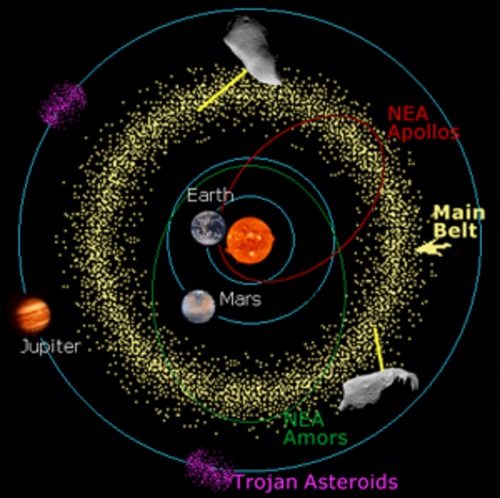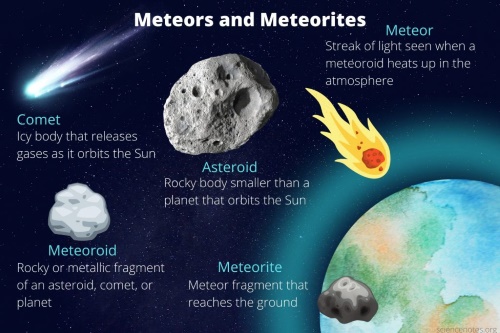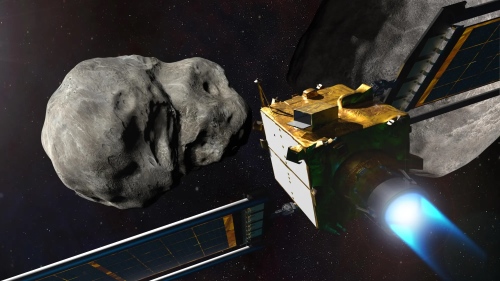Key Takeaways:
- ESA is actively monitoring asteroid 2024 YR4, which has a 1.2% chance of impacting Earth in 2032.
- NEOs, which include asteroids and comets, can vary in size and orbit, with some posing potential hazards to Earth.
- The history of asteroid impacts, such as the Tunguska Event and Chicxulub Crater, shows the potential destructive power of NEOs.
- International efforts, including the International Asteroid Warning Network (IAWN), are critical for tracking and mitigating the risks posed by NEOs.
NASA and the European Space Agency are actively monitoring asteroid 2024 YR4, which has a 1.2% chance of colliding with Earth on December 22, 2032. The director of NASA’s Center for Near-Earth Object Studies emphasized that while there is a 99% likelihood that the asteroid will miss Earth, it remains a significant object of interest. The asteroid's trajectory is being closely tracked, and further observations are expected to provide more precise data, refining the impact probability and ensuring accurate risk assessment for future mitigation efforts.
NASA analysis of near-Earth asteroid 2024 YR4 indicates it has >1% chance of impacting Earth on Dec. 22, 2032, which also means there's ~99% chance this asteroid will not impact. Such initial analysis will change over time as more observations are gathered https://t.co/LMFH12K9N8 pic.twitter.com/WyXh0uUqeq
— NASA Asteroid Watch (@AsteroidWatch) January 29, 2025
The European Space Agency (ESA) has been closely monitoring Asteroid 2024 YR4, which was discovered on December 27, 2024, by the Asteroid Terrestrial-impact Last Alert System (ATLAS) telescope in Chile. While the asteroid has an overwhelmingly high probability of passing Earth safely, it poses a potential risk that could have significant consequences for the planet.
This article combines insights on Near-Earth Objects (NEOs) and the specifics of Asteroid 2024 YR4, along with a deeper exploration of their potential dangers and impact mitigation efforts.
Key Details of Asteroid 2024 YR4
| Factor | Details |
| Discovery Date | December 27, 2024 |
| Size | Estimated between 40 m and 100 m wide |
| Risk of Impact | 1.2% probability of impact on December 22, 2032 |
| Impact Hazard Rating | Level 3 on the Torino Impact Hazard Scale (indicating a close encounter) |
| Current Status | Continuous monitoring by ESA and other space agencies |
| Follow-up Observations | Ongoing with advanced telescopes, including the Very Large Telescope (VLT) in Chile |
What Are Near-Earth Objects (NEOs)?
Near Earth Objects (NEOs) are asteroids or comets that were once part of the Asteroid belt but were pulled out of place due to gravitational interactions or collisions with other objects.
Speaking of the size and orbit of NEOs, most NEOs are smaller than 1 km in diameter, but objects can be as large as 40 km. NEOs orbit within 1.3 AU (astronomical units) of the Sun.

Source: ESA
Difference between asteroids, comets, and meteoroids

Source: sciencenotes.org
NEOs are classified into asteroids, comets, and meteoroids. Let us look at the differences between them.
| Category | Asteroids | Meteors & Meteor Showers | Comets |
| Definition | Rocky bodies orbiting the Sun, too small to be planets. | Small rocks or debris burn up in Earth's atmosphere, creating streaks of light. | Icy bodies are composed of rock, dust, and frozen gases from the outer solar system. |
| Origin | Leftovers from the early solar system formation. | Fragments from asteroids or comets enter Earth’s atmosphere. | Originate from the Oort Cloud or Kuiper Belt. |
| Size | Vary from tiny rocks to large ones like Vesta, Ceres, and Hygiea (diameters over 400 km). | Usually small, but larger ones that reach Earth’s surface are called meteorites. | Can be several kilometers in diameter. |
| Location | Mostly in the asteroid belt between Mars and Jupiter. Some, called Trojan asteroids, share planetary orbits. | Occur in Earth's atmosphere; meteorites land on Earth's surface. | Travel in elongated orbits around the Sun. |
| Special Types | Near-Earth Objects (NEOs) are asteroids that pass close to Earth. | Meteor showers occur when Earth passes through debris left by comets or asteroids. | Have glowing tails when approaching the Sun due to ice vaporization. |
| Scientific Importance | Provide insights into the formation of the solar system. | Help study space debris and its impacts on Earth. | May have delivered water and organic compounds to early Earth, influencing the development of life. |
Evolution of NEO Detection Techniques
Early Techniques
Initially, NEO discovery relied on photographic film comparisons. Two images of the same sky region were taken several minutes apart and compared using:
- Blink comparators: Detected moving NEOs by making them appear to "jump."
- Stereomicroscopes: Created a 3D effect making NEOs "rise" above background stars.
Modern Techniques
Presently, Charged-Coupled Devices (CCDs) have replaced photographic films. CCD cameras record images digitally with a resolution of around 2000 × 2000 pixels.
The detection process includes taking three or more images of the same sky region at intervals. Images are compared to detect the systematic movement of objects. The object's movement, brightness, and direction help determine its distance, size, and orbit. Computer-aided analyses assist detection, but human verification is still used.
The Risks of NEOs and Past Impact Events
Historically, NEOs have impacted Earth, creating substantial damage. The Meteor Crater in Arizona, USA, is a prominent example, formed by an object just 40–50 m in size. Other notable impacts include:
- Chicxulub Crater: Believed to have contributed to the mass extinction of the dinosaurs.
- Tunguska Event (1908): A meteor exploded above Siberia, flattening 80 million trees, despite being under 50 m in size.
- Chelyabinsk Event (2013): A smaller event, but it demonstrated that even smaller NEOs can have significant consequences.
The Potential Impact of Large NEOs
While large NEO impacts are rare, their potential to cause catastrophic consequences cannot be ignored. A large asteroid impact could:
- Shockwave: Create devastating shockwaves, high-speed winds, and earthquakes.
- Global Temperature Change: The dust and vapor released could block sunlight, leading to a "nuclear winter" effect.
- Disruption of Photosynthesis: A lack of sunlight would disrupt plant life, potentially causing mass extinctions.
Planetary Defense Strategies: DART Mission and Future Asteroid Impact Prevention Plans
Planetary defense is the systematic effort to detect, track, and mitigate potential asteroid or comet impacts that could threaten Earth. With numerous near-Earth objects (NEOs) detected annually, agencies like NASA, ESA, and other global space organizations are investing in research and technology to prevent catastrophic collisions.
Among the planetary defense strategies for NEOs include early detection and monitoring, impact prediction and risk assessment, and deflection and mitigation techniques. Let us learn about them in detail.
Early Detection and Monitoring
Organizations like NASA’s Near-Earth Object Observations (NEOO) Program and ESA’s Flyeye Telescope actively track asteroids. The NEOWISE Mission and the upcoming Near-Earth Object Surveyor (NEO Surveyor) aim to identify hazardous asteroids well in advance.
Impact Prediction and Risk Assessment
The Sentry System by NASA continuously analyzes the impact probabilities of known NEOs.
The Asteroid Terrestrial-impact Last Alert System (ATLAS) provides early warnings for smaller objects.
The Planetary Defense Coordination Office (PDCO) manages risk mitigation efforts globally.
Deflection and Mitigation Techniques
If an asteroid is on a collision course, several deflection strategies can be employed:
- Kinetic Impact: Striking the asteroid with a high-speed object to alter its trajectory.
- Gravity Tractor: Using a spacecraft's gravitational pull to gradually shift the asteroid’s path.
- Nuclear Explosions: Detonating a nuclear device near the asteroid to nudge it away.
- Laser Ablation: Using high-energy lasers to vaporize asteroid material, causing a shift in motion.
- Solar Sailor Paint Method: Altering an asteroid’s reflectivity to change its course via radiation pressure.
2023 National Planetary Defense Strategy
The 2023 National Planetary Defense Strategy enhances U.S. preparedness against Near-Earth Object (NEO) threats for the next decade, updating the 2018 plan. It focuses on:
- Detection & Tracking: Strengthening NEO identification.
- Risk Assessment: Advancing research and impact prediction.
- Response Planning: Improving emergency preparedness.
- Global Cooperation: Enhancing international collaboration.
DART Mission: The First Planetary Defense Test
Overview
NASA’s Double Asteroid Redirection Test (DART), launched on November 24, 2021, was the first real-world demonstration of the kinetic impactor technique.

Source: science.nasa.gov
Objectives
- Test whether a spacecraft could intentionally collide with an asteroid to change its motion.
- Observe the effects on Dimorphos, a small moonlet of the asteroid Didymos.
Mission Outcome
- On September 26, 2022, DART successfully impacted Dimorphos.
- Observations confirmed a change in the moonlet’s orbital period, proving kinetic impact is a viable planetary defense strategy.
Future Plans for Asteroid Impact Prevention
Hera Mission (ESA - 2024)
- A follow-up to DART, Hera will study Dimorphos in detail to assess the long-term effects of the impact.
- Data will refine asteroid deflection models for future missions.
NEO Surveyor Mission (NASA - 2027)
- A dedicated space telescope designed to detect and characterize hazardous asteroids.
- Aims to identify 90% of NEOs larger than 140 meters.
Hypervelocity Asteroid Mitigation Mission for Emergency Response (HAMMER)
- The proposed mission combines nuclear impactors and kinetic deflectors.
- Designed for scenarios where last-minute intervention is needed.
Joint Global Initiatives
- International Asteroid Warning Network (IAWN) and Space Mission Planning Advisory Group (SMPAG) coordinate global efforts for planetary defense.
- Countries like China and Russia are exploring independent asteroid deflection missions.
Comments
All Comments (0)
Join the conversation